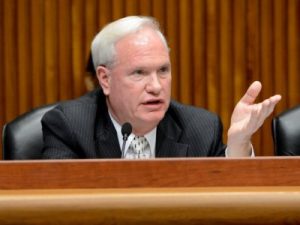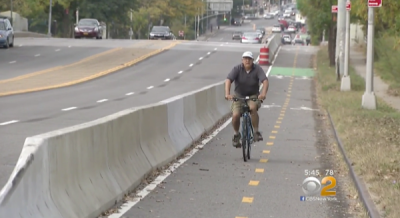Senate District 11 Showdown: John Liu vs. Tony Avella
The bike-lane-hostile incumbent declined our requests for comment.

We begged. We pleaded. We wrote no less than a dozen emails and calls imploring State Senator Tony Avella to respond to our candidate questionnaire so that Streetsblog readers can know his opinions on street safety issues — without any editing by us.
State Senator Tony Avella declined.
As such, we only have questionnaire answers from his challenger, former Council Member and City Comptroller John Liu, who is seeking to return to politics by picking off Avella in his Eastern Queens district.
It’s the only one-sided campaign “debate” we’ve had (the rest are archived here), but it’s no surprise that Avella blew off Streetsblog and its readers. The Senator has been belligerent to street safety advocates for years.
Here’s where he chose to ignore safety data so he could continue to oppose safety improvements.
Here’s where he fought a city safety effort on Northern Boulevard.
Here’s where he opposed tolling East River bridges.
Here’s where he opposed a pedestrian plaza in Flushing.
Here’s where he opposed dropping the speed limit to 20 mph.
Those are just from our pages. No coverage of Avella is complete, however, without this video of him berating street safety advocates:
.@TonyAvella bullying his constituents from attending a newly indoors press conference to oppose #FixNorthern pic.twitter.com/gOgL4KWamO
— Juan Restrepo ? (@juaninQNS) September 18, 2017
Liu has proven to be an inconsistent supporter of cyclists over the years.
Here’s where he pushed the tired line about helmets.
And here’s where he pandered to drivers.
But Liu is also out front on beefing up the NYPD’s crash investigation team. And he supports congestion pricing.
So without further ado, here are Liu’s answers, unedited, with a map of the district at the bottom of this post. (Caveat: It is unclear if Liu himself answered, or whether the responses came from a campaign worker, as the questionnaire repeatedly refers to “John” rather than “I.”)
Do you support congestion pricing in New York City? If so, in what form? If not, why not?

With regard to MTA finances, the State should resume directly shouldering some MTA needs in the State’s capital budget (as it used to). This would relieve pressure on fare increases by containing the growth in debt service on MTA-issued bonds.
AVELLA: No response.
Subway ridership is down and New York’s buses are slower than ever. What will you do in Albany/are doing in Albany to fix it?
LIU: Subway ridership is reaching capacity limitations during peak hours. Peak and off-peak pricing should be examined as a way to spread the passenger load more evenly throughout the day. To allow buses to move quicker and more efficiently, bus rapid transit, select buses, and dedicated lanes otherwise should be incorporated into the transportation landscape with community input. Faster fare collection is also key to this.
AVELLA: No response.
MTA capital projects routinely cost five times as much as transit projects in other cities. How will you exert pressure on the MTA to control costs?
LIU: Capital project costs should be better managed with tighter operational management. MTA management needs to better plan repair and upgrade work in the subway system and minimize subway downtime. My audit a few years ago showed that subways were shut down longer and more often than really needed for the MTA to conduct their “necessary track work.”
AVELLA: No response.
How would you make streets in your district safer for walking and biking? Do you support the city’s construction of protected bike lanes? If so, why? If not, why not?
LIU: John supports more protected bike lanes and greenways for pedestrians skaters and cyclists alike. The city DOT and Parks Dept need to be more engaging in community input. Once lanes and ways are established, they must be well-maintained. For example, too many bike lanes in New York are rendered unusable due to accumulation of debris and inadequate pavement maintenance.
AVELLA: No response.
What is the single biggest thing the state should do to get reckless drivers off New York City streets?
LIU: More cameras to monitor traffic light, speed limit, bus lane, and other violations.
AVELLA: No response.
Is there a safety, design or enforcement strategy that is not being deployed that you think is vital to making our roadways, sidewalks and public spaces work better for everyone? (Hint: This is a “visionary” question, so don’t think small.)
LIU: Driverless cars are not yet safely feasible but will be inevitable. This may afford an opportunity in the future by better allocating scarce street space among pedestrian, cyclist and motorist needs.
AVELLA: No response.
How often do you bike to the office (be honest)?
LIU: John bikes to work (Baruch and Columbia) always unless weather is inclement.
AVELLA: No response.


